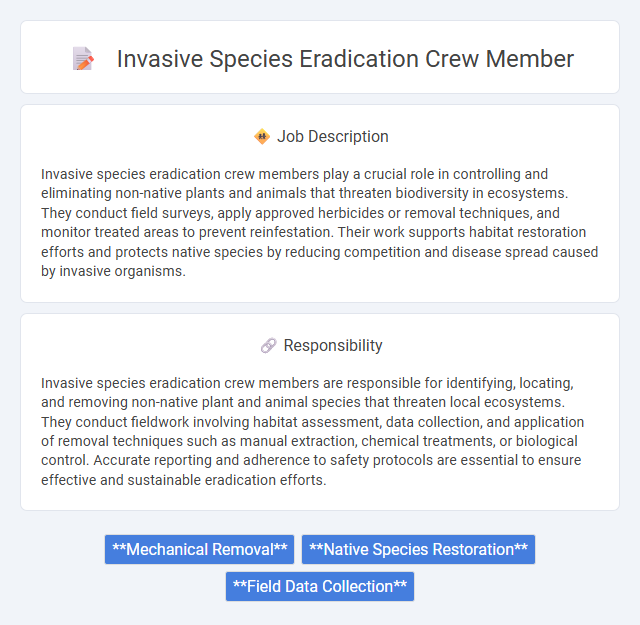
Invasive species eradication crew members play a crucial role in controlling and eliminating non-native plants and animals that threaten biodiversity in ecosystems. They conduct field surveys, apply approved herbicides or removal techniques, and monitor treated areas to prevent reinfestation. Their work supports habitat restoration efforts and protects native species by reducing competition and disease spread caused by invasive organisms.
Candidates with strong physical endurance and a willingness to work outdoors in varying and sometimes harsh environmental conditions are likely to be suitable for an invasive species eradication crew member role. Individuals comfortable with repetitive manual labor, teamwork, and problem-solving in unpredictable settings may find this job compatible with their skills and temperament. Those prone to health issues or discomfort with remote fieldwork might face challenges in performing effectively in this position.
Qualification
Invasive species eradication crew members must possess a strong understanding of local ecosystems, plant identification, and safe pesticide application techniques. Physical fitness and the ability to work in remote, rugged environments are essential for executing removal and monitoring tasks effectively. Experience with GIS mapping, data collection, and adherence to environmental regulations significantly enhances job performance and qualification.
Responsibility
Invasive species eradication crew members are responsible for identifying, locating, and removing non-native plant and animal species that threaten local ecosystems. They conduct fieldwork involving habitat assessment, data collection, and application of removal techniques such as manual extraction, chemical treatments, or biological control. Accurate reporting and adherence to safety protocols are essential to ensure effective and sustainable eradication efforts.
Benefit
Working as an invasive species eradication crew member likely offers substantial benefits such as gaining hands-on experience in environmental conservation and contributing directly to ecosystem restoration. Team members probably develop valuable skills in fieldwork, data collection, and species identification, which can enhance future career opportunities. The role may also provide physical activity in outdoor settings, promoting personal health and a strong sense of purpose.
Challenge
Working as an invasive species eradication crew member likely involves facing challenging environmental conditions, such as dense vegetation, rugged terrain, and unpredictable weather. The work may require physical endurance and problem-solving skills to effectively locate and remove invasive species while minimizing damage to native ecosystems. Crew members probably encounter logistical difficulties in remote areas, making teamwork and adaptability crucial to success.
Career Advancement
Invasive species eradication crew members gain specialized skills in environmental management and biological control techniques, enhancing their career prospects within conservation and ecological restoration sectors. Experience in field data collection, species identification, and the use of eradication tools opens pathways to supervisory roles, environmental consultancy, and governmental wildlife management positions. Continuous training and certification in invasive species protocols further accelerate advancement opportunities in this expanding environmental field.
Key Terms
Mechanical Removal
Mechanical removal specialists in invasive species eradication crews employ heavy machinery, hand tools, and equipment to physically extract non-native plants and pests from ecosystems, preventing their spread. Expertise in operating excavators, brush cutters, and root rakes enables efficient disturbance of invasive root systems and vegetation, crucial for habitat restoration. Successful mechanical removal minimizes chemical use, promotes native biodiversity, and supports long-term ecosystem resilience.
Native Species Restoration
Invasive species eradication crew members play a critical role in native species restoration by removing non-native flora and fauna that disrupt local ecosystems. Their efforts facilitate the recovery of indigenous plants and wildlife, promoting biodiversity and ecosystem resilience. Proficient use of targeted removal techniques and habitat monitoring ensures the successful reestablishment of native species populations.
Field Data Collection
Invasive species eradication crew members conduct precise field data collection to monitor ecosystem health and track invasive populations, utilizing GPS technology and digital mapping tools for accurate geographic data. They document species identification, population density, and treatment outcomes, enabling data-driven decision-making and adaptive management strategies. This role ensures comprehensive, real-time data input critical for effective invasive species control and restoration efforts.
 kuljobs.com
kuljobs.com